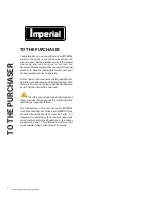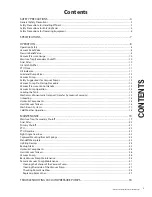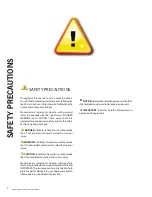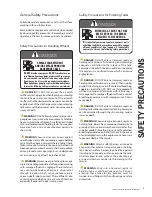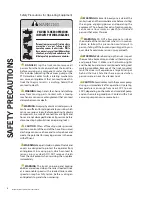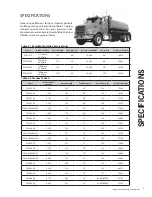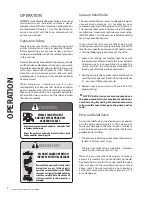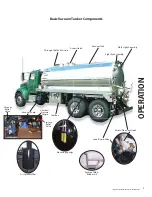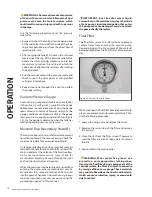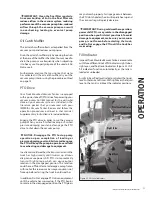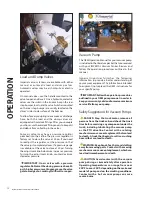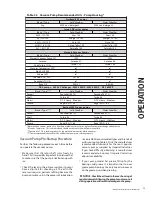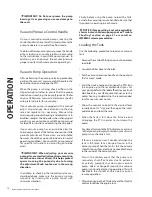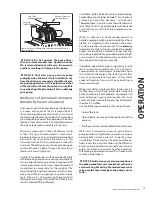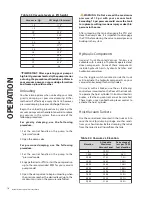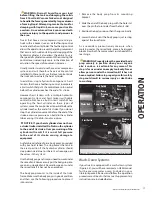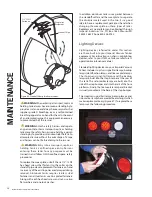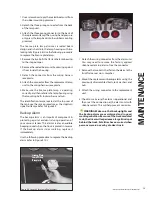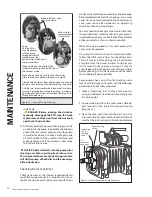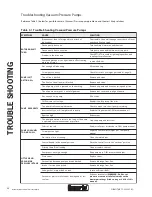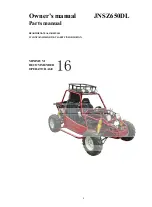
15
IMPERIAL TRUCK MOUNTED VACUUM TANKER MANUAL
►
NOTICE: Do Not operate the pump faster
than the recommended rpm. Operation above
the recommended rpm will cause the pump to
overheat, resulting in damage to the pump.
►
NOTICE: Shut down your vacuum pump
promptly when the tank is full. In addition, any
time the primary or secondary shutoff activates,
stop pump operation. At the point when either
of the shutoffs activates, the pump is susceptible
to overheating if kept running. This can damage
your pump.
Mechanics of pneumatic-transport
(transfer by means of vacuum)
A vacuum, as pertaining to pumping of liquid waste,
is a space with some of the air removed from it.
Your vacuum pump extracts air from your vacuum
tank, lowering the pressure inside of it. Atmospheric
pressure pushing against the liquid does the actual
loading of your vacuum tank. The liquid flows toward
the area of lower pressure created in the tank.
Vacuum is measured in inches of Mercury (in.Hg.
or “Hg.). This type of measurement is based on a
barometric mercury column. Standard atmospheric
pressure at sea level causes the mercury in this
instrument to rise 0 inches up into a glass tube with
a vacuum. The dial type pressure/vacuum gauge on
your tank (Figure .2, page 11) gives the same in.Hg.
reading as a mercury column.
Usually, 15” Hg of vacuum is sufficient to load the tank
without placing undue stress on your pump. Table .
lists the approximate vacuum levels required to lift
water a given distance. However, these figures must
be adjusted to compensate for the weight of the
material and the length and diameter of suction hose
being used. Effluent or septage may often weigh
more than water. Also, pumping these products
through a hose induces friction. Both of these factors
result in reduced lifting efficiency.
OPERA
TION
Drip Oiler
Sight Window
Drip Oiler
Adjustment Knob
Figure 3.4 Vacuum Pump Drip Oiler and Vacuum/Pressure
Control Handle
Vacuum/Pressure
Control Handle
In addition, both attainable vacuum and pumping
height decrease at higher altitudes. This is because
atmospheric pressure decreases with height.
Therefore, there is less pressure at hand to load your
tank. Table .4 lists the percentage loss of attainable
vacuum for every 1000-foot rise in elevation over
sea level.
While it is necessary to create enough vacuum to
handle pumping height, product weight, and hose
friction, it is important not to overstress the pump.
Pay close attention to your pump if it is
necessary
to operate at a high in./Hg vacuum level. Air-cooled
pumps are especially vulnerable to overheating
when being operated for extended periods at high
vacuum levels. Liquid cooled pumps can handle this
type of operation much more readily.
In addition, operation at high in./Hg levels can also
result in moisture condensation in the pump. As
vacuum increases, water begins to evaporate from
the surface of the liquid in the tank. Anytime that
vacuum pump operation exceeds 15”Hg, water
vapor can begin to show up in the air circulating in
the vacuum system.
While most of this moisture collects in the oil catch
muffler, some of it will also accumulate inside the
pump. In order to prevent problems connected with
water collecting in your vacuum pump, dry it out
anytime that you notice that water has collected in
the oil catch muffler.
Use the following procedure to dry the pump out:
•
Unload the tank
•
Open a load or dump valve (to keep from building
vacuum)
•
Run the pump in vacuum mode for two to five minutes
Water that is allowed to remain in your vacuum
pump can diminish performance and cause serious
damage. When water is present inside the pump,
sludge forms. This can restrict the vanes from moving
freely inside the rotor slots, reducing the efficiency
of your pump. In addition, water inside your vacuum
pump can freeze during cold weather operation.
Attempting to operate your pump if it is frozen inside
with ice will damage it.
►
NOTICE: Do Not run your vacuum pump above
the pump manufacturer’s maximum continuous
vacuum rating. Exceeding the maximum vacuum
rating could cause damage to the pump and/or
tank.


